Bats in the Belfry But Not in Your Hair
Misconceptions color human perception of these amazing creatures
November 16, 2023
Hollywood and literature routinely portray bats as blood-sucking monsters. It’s entertaining, but in reality, humans are a much bigger threat to these winged mammals than they are to us. In fact, their presence is beneficial in numerous ways.
Bats play an important role in the control of mosquitoes and agricultural pests. They save the United States about $1 billion annually in pest control. Bats in the Southwest and other warm areas around the world help plants grow by pollinating flowers. When nectar-drinking bats stick their long noses into flowers, they become covered in pollen that they then bring to other flowers. Through pollination, bats help grow avocados, bananas, and mangoes. In all, some 300 species of fruit depend on bats for pollination.
Also, of the 1,400 or so bat species worldwide, only three — the common vampire bat, the hairy-legged vampire bat, and the white-winged vampire bat — feed solely on blood, mostly that of birds. You would have to travel much further south than southern New England to find one.
Bats come in all shapes and sizes, from the tiny bumblebee bat that weighs less than a penny to flying foxes that can have a wingspan of up to 6 feet. Bats are the only mammal that can fly — although some other mammals glide, such as flying squirrels.
The eight species of bats that can be found in Rhode Island are divided into two classes: tree bats (eastern red bat, hoary bat, and silver-haired bat) and hibernators (little brown bat, big brown bat, tricolored bat, northern long-eared bat, and eastern small-footed bat). They are all insectivores.
In the whole of the United States, about 50 species of bats can be found.
Many bat species here and abroad, however, are facing several threats: disease, habitat loss, logging, pollution from pesticides and insecticides, and human fear.
Forest fragmentation, destruction of roosts, and human-wildlife conflict are all causing a decline in bat populations. Nearly a quarter of bat species worldwide are considered critically endangered, endangered, or vulnerable.
Bat numbers in the United States and Canada have declined dramatically because of white-nose syndrome, a disease that has killed more than 6 million bats in the past decade.
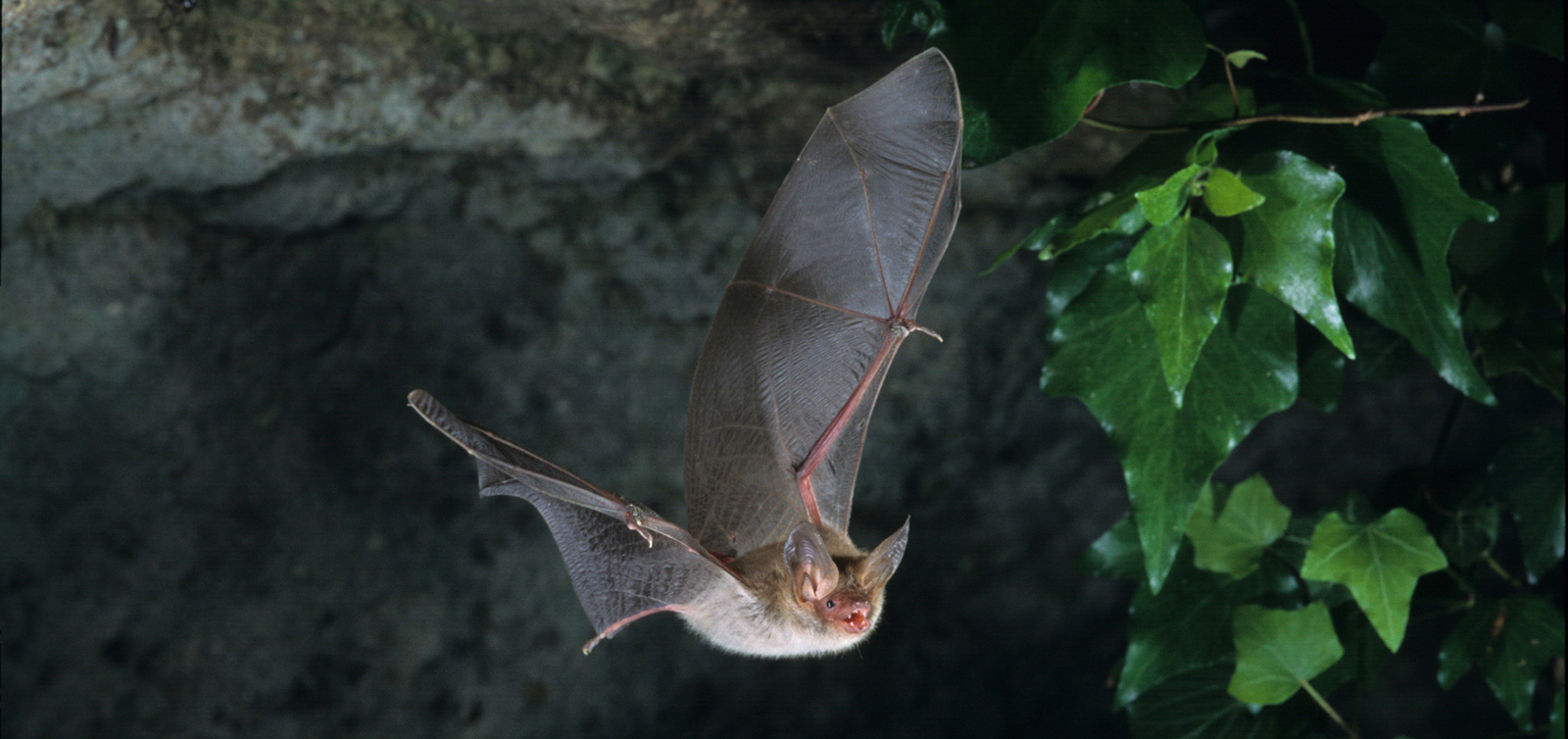
Bats live in a variety of habitats, including fields, forests, wetlands, and agricultural areas. They usually feed in areas where insects swarm, such as over water and agricultural fields, in forest clearings, and along forest edges. Basically, they live almost everywhere on Earth except the most extreme deserts and polar regions.
Bats are the primary predator of night-flying insects. The non-vampire ones can consume up to a few thousand insects a night. Nearly 70% of bat species feed primarily on insects, but some eat rodents, frogs, and fish.
To locate their prey, most insect-eating bats use a system called echolocation, which is similar to sonar used on ships. These bats emit a high frequency sound that bounces off objects in their environment. They can then determine the location and size of prey by listening to the sound echo that returns to them.
Bats aren’t blind, however. Their eyesight is similar to that of humans.
A few other misconceptions that, like a tick, have buried themselves in the species.
For one, bats aren’t “rodents/rats/mice with wings.” They are in their own mammalian order called Chiroptera, which in Greek means “hand wings.” Although they are small like rodents, bats are more closely related to primates and humans than they are to mice, rats, or flying squirrels.
Bats are extremely long-lived for their size, but also have one of the slowest reproductive rates for animals their size. Peter August, a retired professor of natural resources at the University of Rhode Island who spent his undergraduate and graduate years studying small mammals, including bats, said pups, typically born in late spring/early summer, have a 90% mortality rate.
“Those young-of-the-year bats are clumsy feeders, they’re new at flying, and they just don’t have the ability to put on all that fat mass to get through that first winner,” August said.
Some bats that survive the first year, can live up to 35 years, compared to rats that live 1-2 years. Furthermore, female bats usually only give birth to one pup a year whereas rats give birth to many offspring, multiple times a year.
Also, bats don’t purposely — and seldom accidentally — fly into people with long hair. While they may swoop over you at night, it’s because they are foraging for the insects flying above you. They’re not interested in your hair.
“I don’t know if they would know what to do with your hair once they got in it,” August said.
While here, especially in late October, bats are considered spooky, August noted that’s not a universally held belief.
“If you look at Chinese art, Chinese furniture, Chinese plates, you’ll frequently see outlines of bats on them, because bats are considered a sign of good luck and good fortune,” he said. “So in some parts of the world, people hold bats in high regard.”
As for rabies, that isn’t a misconception about bats, according to August. But, he noted, skunks, foxes, and raccoons have a higher frequency for rabies. He said about 4% of bats test positive for rabies.
“Nevertheless, bats, like other animals, can carry rabies,” August said. “If you have a bat in the house, you’ve got to be thinking about rabies. Bats have very small teeth. They’re like little needles. You don’t need big old chompers to eat a mosquito. You could easily be bit by a bat in the house at night and not know it because it wouldn’t be a big wound.”
Most bats only spend the summer in Rhode Island and migrate or hibernate elsewhere during the colder months. Bats that hibernate typically select a natural cave or abandoned mine with stable, above-freezing temperatures and high humidity. Rhode Island doesn’t have any mines or natural caves, which is why most hibernating bats leave Rhode Island in early fall.
Rhode Island’s three species of tree bats are generally solitary, and in any given winter, they can be found in the state, sometimes overwintering inside buildings. Red bats will hibernate on the ground, under leaf litter.
“We assume that the tree bats found here in the winter are bats that have migrated from areas north of Rhode Island and may have been forced to stop here due to cold weather,” according to the Rhode Island Department of Environmental Management.
Here is a closer look at Rhode Island’s bats:
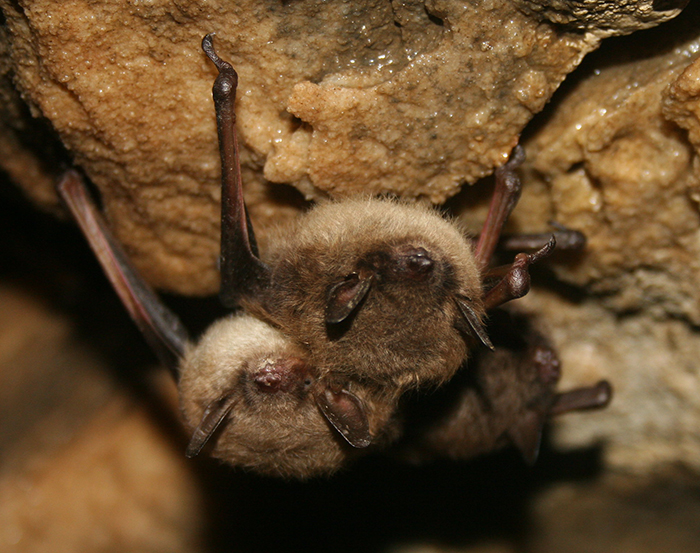
LITTLE BROWN BAT
Scientific name: Myotis lucifugus
Range: From Alaska-Canada boreal forests south through most of the contiguous United States and into high-elevation forests in central Mexico.
Food: Wide variety of flying insects, including mosquitoes; small beetles; and spiders.
Life span: Up to 30 years, but 6-7 years is typical.
Fun fact: Hibernation occurs over winter. During this time, these bats can withstand a temperature change of nearly 120 degrees Fahrenheit without suffering any damage.
Little brown bats are, well, little. They weigh only a quarter to a third of an ounce, are about 2 inches long, and have a 6-inch wingspan. They’re also brown.
They are nocturnal and hunt most actively for a few hours after dusk. They must eat half their body weight in insects per night to prevent malnourishment. New mothers sometimes eat more than their own body weight in a single night.
New England populations of the little brown bat, historically the region’s most common species, were decimated by white-nose syndrome, a fungus that spreads rapidly through colonies of hibernating bats. The sickness was first discovered in 2006 in a cave in upstate New York.
In New England, most little brown bats hibernate in caves in Vermont and New Hampshire.
“Female little brown bats are here in the summer in their maternity roosts, where they’re not exposed to white-nose syndrome,” Charlie Brown, a since-retired wildlife biologist with the R.I. DEM, told ecoRI News in 2021. “But they’ve come from a cave somewhere like Vermont where they’ve been exposed to it all winter, and then they go back there the following winter and may be re-exposed. We’ve learned that some bats have developed a resistance and are persevering, but every year bats are dying and not coming back.”
Males don’t spend time in maternity roosts
Brown noted the species’ New England numbers appeared to be recovering, albeit slowly.
“It’s speculative at this point, but from what I see anecdotally and in the data, we’re seeing evidence of recovery,” Brown said. “It seems like they hit bottom — at least I hope they did — and we’re seeing evidence of the bats rebounding and recovering to some degree.”
Rebuilding bat populations is a long, slow process, according to Brown. Female bats give birth to just one pup each year, and the pup survival rate during their first year is only about 50%.
“We’re not going to see a significant recovery in our lifetime,” Brown said. “We’re not going to see numbers we used to see for a long time. We need to think long-term about protecting maternity roost sites. If they’re going to recover, they need habitat, they need places to feed, they need places to raise their young. We’re going to have to maintain our forests and open spaces. If we don’t protect habitat, there won’t be a place for bats to come back to.”

BIG BROWN BAT
Scientific name: Eptesicus fuscus
Range: Northern Canada, throughout the United States and south to the extreme southern tip of Mexico. Their habitat ranges from timberline meadows to lowland deserts, though they are most abundant in deciduous forests and in suburban areas of mixed agricultural use.
Food: Small beetles are their most frequent prey, but they also consume large quantities of night-flying insects.
Life span: They can live up to 20 or more years, but the average lifespan is considerably less.
Fun fact: They can migrate hundreds of miles.
Big brown bats hibernate in smaller colonies — frequently in attics, walls of buildings, and chimneys — and are not as prone to fungal infection, according to August.
They weigh between one-half and three-quarters of an ounce and their wingspans range from 13 to16 inches. Their fur is long, tends to be oily, and ranges from light to dark brown, contrasting with the black of their muzzle, ears, and wing membranes. Their ears are short and blunt and their snout and mouth are broad.
Like many bat species, reproductive females often consume their body weight in insects every night when not hibernating. In fact, a colony of 150 big brown bats can consume enough adult cucumber beetles in one summer to prevent egg-laying that would produce 33 million of their root-worm larvae, a major pest of corn.
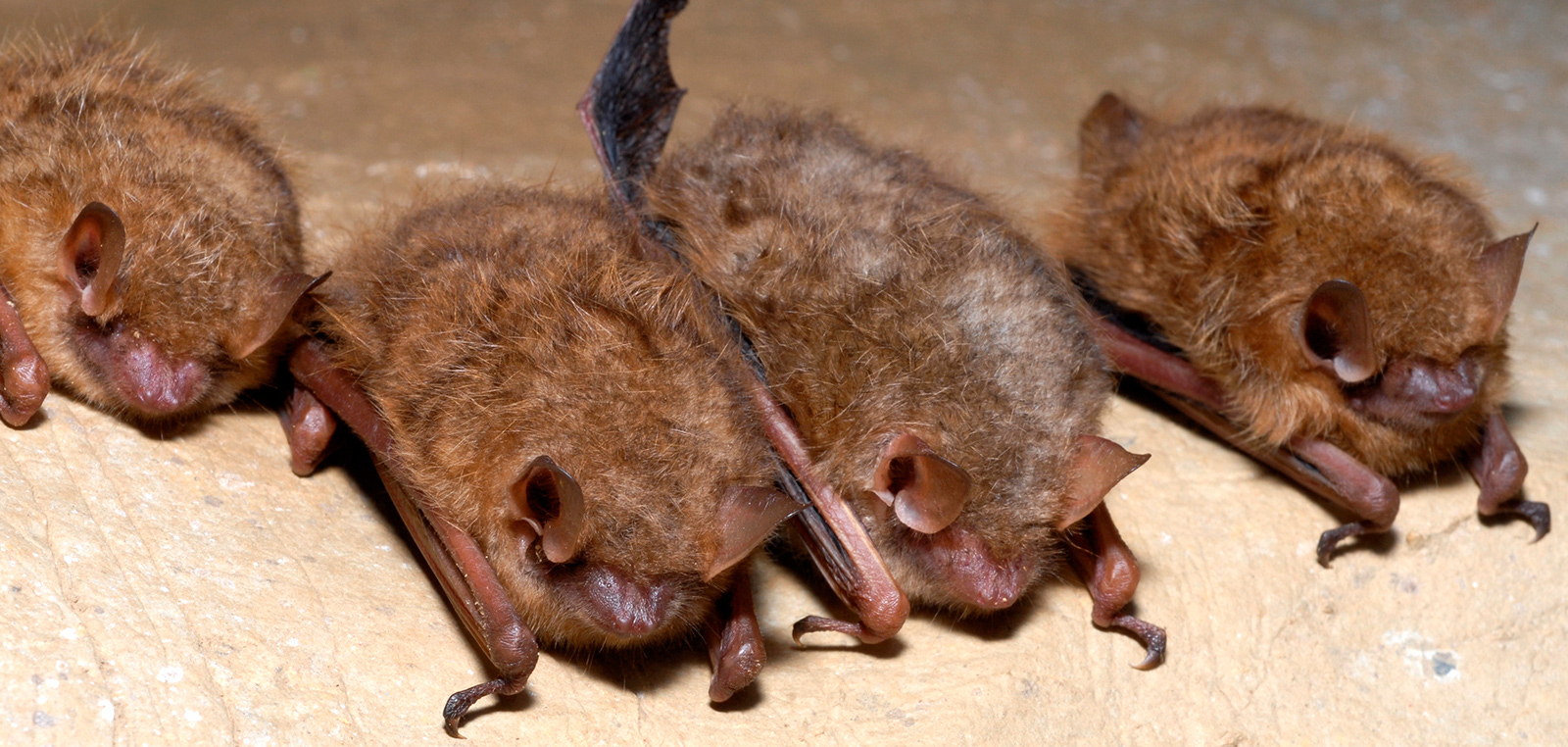
TRICOLORED BAT
Scientific name: Perimyotis subflavus
Range: The once common species is wide-ranging across the eastern and central United States and portions of southern Canada, Mexico, and Central America.
Food: They are opportunistic feeders and consume small insects, including caddisflies, moths, beetles, wasps, flying ants, and flies.
Life span: The oldest tricolored bat on record is a male recaptured 14.8 years after it was originally captured and banded.
Fun fact: They are weak fliers and are often mistaken for moths.
As its name suggests, the tricolored bat is distinguished by its unique tricolored fur that appears dark at the base, lighter in the middle, and dark at the tip. Their a average body length is 3 to3.5 inches. An adult male weighs on average 0.26 ounces and a female 0.28 ounces.
In September 2022, the U.S. Fish & Wildlife Service announced a proposal to list the tricolored bat as endangered under the Endangered Species Act. The species faces extinction due primarily to the range-wide impacts of white-nose syndrome.
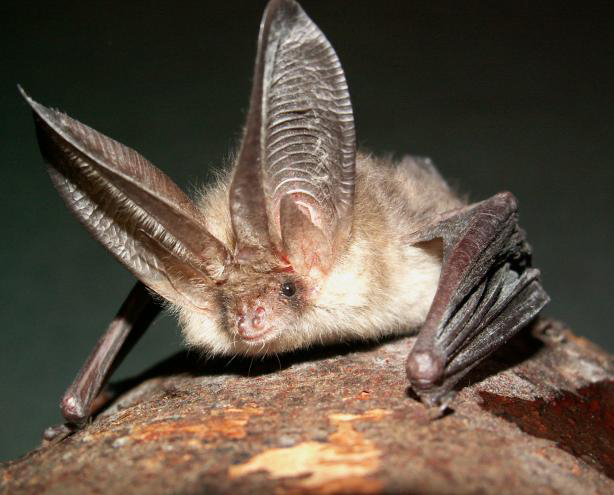
NORTHERN LONG-EARED BAT
Scientific name: Myotis septentrionalis
Range: All or portions of 37 states, the District of Columbia, and eight Canadian provinces.
Food: A diverse diet that includes moths, flies, leafhoppers, caddisflies, beetles, and arachnids.
Life span: The maximum is estimated to be up to 18-plus years.
Fun fact: They typically capture their prey by gleaning them directly off surfaces rather than catching them in flight.
Northern long-eared bats are medium-sized, at about 3 to 3.7 inches in length but with a wingspan of 9 to 10 inches. An adult’s body weight averages 5 to 8 grams (0.2 to 0.3 ounces), with females tending to be slightly larger than males. Their fur color can be medium to dark brown on the back and tawny to pale brown on the underside. As its name suggests, this bat is distinguished by its long ears, particularly as compared to other bats in its genus Myotis.
Like the tricolored bat, the the U.S. Fish & Wildlife Service, in March 2022, announced a proposal to reclassify the northern long-eared bat as endangered, due largely to white-nose syndrome.

EASTERN SMALL-FOOTED BAT
Scientific name: Myotis leibii
Range: Southern Ontario and Quebec in Canada and in mountainous portions of the eastern United States from New England to northern Georgia, and westward to northern Arkansas.
Food: Primarily flies and moths.
Life span: 6 to 12 years.
Fun fact: This species is among the rarest in the United States. In March 2022, state biologists recorded the first sighting of the species in Rhode Island. The bat’s unique call signature had been heard here before, but the species’ presence was never visually confirmed until last year.
During the summers, they roost in rock fields and talus slopes, favoring areas with high sun exposure. Colonies are also occasionally found in stone buildings and bridges.
While the estimated 12% decline of the eastern small-footed bat from white-nose syndrome has been less severe than for other affected bat species, it still constitutes a major loss that, compounded with other threats, puts the species in serious jeopardy.
They are strongly associated with rocky cliffs, talus slopes, and shale fields, where they roost under rocks and in crevices during the day. Because of their dependency on these naturally rare ecological features, small-footed bats are at particular risk from mining, quarrying, oil and gas drilling, hydraulic fracturing, logging, and sprawl.

EASTERN RED BAT
Scientific name: Lasiurus borealis
Range: They are found wherever there are trees east of the Rocky Mountains, from Canada to as far south as central Florida.
Food: Beetles, moths, ants, leafhoppers, and planthoppers.
Life span: About 2 years.
Fun fact: They are North America’s most abundant tree bat.
Eastern red bats roost in the foliage of deciduous or sometimes evergreen trees. Despite their reddish-orange color, this species is actually rather cryptic and can look like dead leaves or pine cones.
For the most part, they are solitary, only gathering together to mate and to migrate. Females even roost singly when rearing young. Unlike most bats, eastern red bats often give birth to twins and can have litters of up to five young, though a litter of three pups is average.
In the summer, they are among the earliest evening fliers. By late fall at the latest, eastern red bats, like other tree bats, are making their way to the southeastern United States to winter.

HOARY BAT
Scientific name: Lasiurus cinereus
Range: Holds the title of the most widespread bat species in the Americas, with a transcontinental range stretching from southeastern Canada to Hawaii. It also can be found in Bermuda and Iceland.
Food: Moths and mosquitoes
Life span: No more than 6 or 7 years.
Fun fact: They typically hang from one foot and look like a dry leaf in a tree.
Summers are spent concealed in the foliage of mature deciduous and coniferous trees, typically near the edge of a clearing. Their distinct gray-white coloration — for which they are named — and furred tail membrane are prime adaptations for this habitat.
They can fly as fast as 13 mph and as high as 8,000 feet during their long-distance migrations in the autumn and spring.
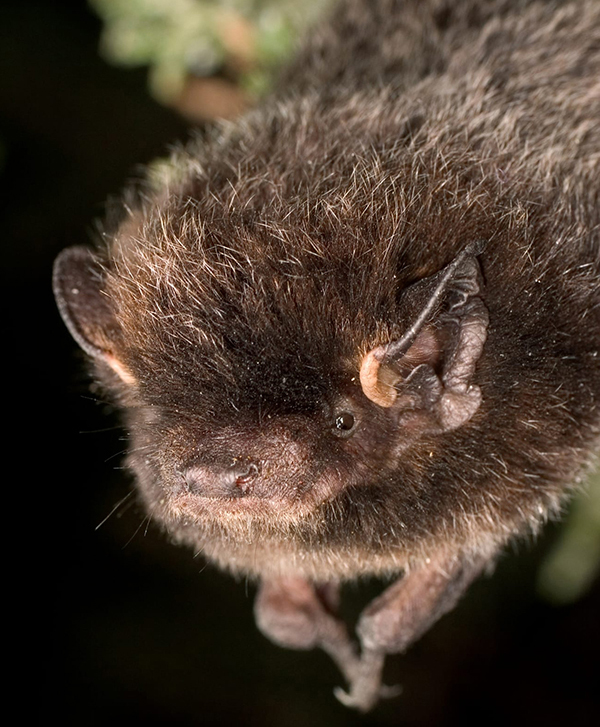
SILVER-HAIRED BAT
Scientific name: Lasionycteris noctivagans
Range: They are found in Bermuda, Canada, Mexico, and the United States.
Food: Feed mainly on small, soft-bodied insects.
Life span: Up to 12 years.
Fun fact: Females typically give birth to two pups, with an even sex ratio.
Silver-haired bats are medium-sized, with black, rarely dark brown, fur with silver tips.
They are dependent upon roosts in old-growth areas, so managing forests for diverse age structure and maintaining forested corridors are important to sustaining the species. It has been estimated that these bats require densities of dead and dying trees — at least 21 snags per hectare.
Note: Much of the information about bats for this story was gathered from the Rhode Island Department of Environmental Management, Bat Conservation International, the U.S. Fish & Wildlife Service, the National Park Service, and the U.S. Forest Service.



